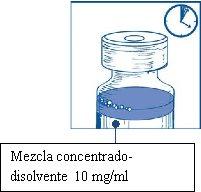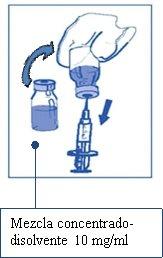
CABAZITAXEL VIVANTA 60 mg CONCENTRADO E SOLVENTE PARA SOLUÇÃO PARA PERFUSÃO

Como usar CABAZITAXEL VIVANTA 60 mg CONCENTRADO E SOLVENTE PARA SOLUÇÃO PARA PERFUSÃO
Introdução
Prospecto: informação para o utilizador
Cabazitaxel Vivanta 60 mg concentrado e dissolvente para solução para perfusão EFG
Leia todo o prospecto atentamente antes de começar a usar este medicamento, porque contém informações importantes para si.
- Conserva este prospecto, porque pode ter que voltar a lê-lo.
- Se tiver alguma dúvida, consulte o seu médico, farmacêutico ou enfermeira.
- Se experimentar efeitos adversos, consulte o seu médico, farmacêutico ou enfermeira, mesmo que se trate de efeitos adversos que não aparecem neste prospecto. Ver secção 4.
C
- O que é Cabazitaxel Vivanta e para que é utilizado
- O que precisa saber antes de que lhe administrem Cabazitaxel Vivanta
- Como usar Cabazitaxel Vivanta
- Efeitos adversos possíveis
- Conservação de Cabazitaxel Vivanta
- Conteúdo do envase e informação adicional
1. O que é Cabazitaxel Vivanta e para que é utilizado
O nome do seu medicamento é Cabazitaxel Vivanta. A sua designação comum é cabazitaxel. Pertence a um grupo de medicamentos denominado “taxanos”, utilizados para tratar cancros.
Cabazitaxel é utilizado para o tratamento do cancro da próstata que progrediu após ter recebido outra quimioterapia. Actua detendo o crescimento das células e a sua multiplicação.
Como parte do seu tratamento, tomará também todos os dias um corticosteroide (prednisona ou prednisolona), por via oral. Peça informações ao seu médico sobre este outro medicamento.
2. O que precisa saber antes de que lhe administrem Cabazitaxel Vivanta
Não use Cabazitaxel Vivanta
- se é alérgico (hipersensível) a cabazitaxel, a outros taxanos, ao polissorbato 80 ou a algum dos outros componentes deste medicamento (incluídos na secção 6),
- se o número dos seus glóbulos brancos é muito baixo (número de neutrófilos menor ou igual a 1.500/mm3),
- se tem problemas graves de fígado,
- se recentemente foi ou vai ser vacinado contra a febre amarela.
Não deve receber Cabazitaxel Vivanta se lhe suceder alguma das circunstâncias anteriores. Se não tem a certeza, consulte o seu médico antes de receber Cabazitaxel Vivanta.
Advertências e precauções
Antes de iniciar o tratamento com Cabazitaxel Vivanta, far-lhe-ão análises de sangue para comprovar que tem células sanguíneas suficientes e que os seus rins e fígado funcionam adequadamente para receber cabazitaxel.
Informa ao seu médico imediatamente se:
- tem febre. Durante o tratamento com cabazitaxel é mais provável que se reduza o número dos seus glóbulos brancos. O médico controlará a sua sangue e o seu estado geral para detectar sinais de infecções. Podia administrar-lhe outros medicamentos para manter o número das suas células sanguíneas. As pessoas com recuentos celulares baixos podem desenvolver infecções que podem pôr em perigo a vida. O primeiro sinal de infecção podia ser febre, por isso se tem febre, informe ao seu médico imediatamente.
- alguma vez teve alguma alergia. Durante o tratamento com cabazitaxel podem produzir-se reacções alérgicas graves.
- tem diarreia grave ou duradoura, sente-se mal (náuseas) ou está mal (vómitos). Qualquer uma dessas situações pode produzir desidratação grave. O seu médico teria que pôr-lhe um tratamento.
- tem sensação de insensibilidade, formigueiro, ardor ou diminuição das sensações em mãos e pés.
- tem algum problema de sangramento no intestino ou tem alterações na cor das suas fezes ou dor de estômago. Se o sangramento ou a dor for grave, o seu médico interromperá o seu tratamento com cabazitaxel. Isto é porque cabazitaxel podia aumentar o risco de sangramento ou desenvolvimento de perfurações na parede intestinal.
- tem problemas de rim.
- tem pele e olhos amarelentos, urina escura, náuseas intensas (sensação de malestar) ou vómitos, pois podem ser sinais ou sintomas de problemas hepáticos.
- nota que o volume da sua urina aumenta ou diminui significativamente.
- tem sangue na sua urina.
Se lhe suceder alguma das circunstâncias anteriores, informe ao seu médico imediatamente. O seu médico podia reduzir a dose deste medicamento ou interromper o tratamento.
outros medicamentos e Cabazitaxel Vivanta
Informa ao seu médico, farmacêutico ou enfermeira se está a utilizar ou utilizou recentemente outros medicamentos, mesmo os adquiridos sem receita. Isto é devido a que alguns medicamentos podem afectar a eficácia deste medicamento ou este medicamento pode afectar a eficácia de outros medicamentos. Estes medicamentos incluem os seguintes:
- cetoconazol, rifampicina (para infecções);
- carbamazepina, fenobarbital ou fenitoína (para convulsões);
- erva de São João ou hipérico (Hypericum perforatum) (planta medicinal utilizada para tratar a depressão e outros problemas);
- estatinas (tais como simvastatina, lovastatina, atorvastatina, rosuvastatina, ou pravastatina) (para reduzir o colesterol no seu sangue);
- valsartano (para a hipertensão);
- repaglinida (para a diabetes).
Enquanto estiver em tratamento com este medicamento, consulte com o seu médico antes de se vacinar.
Gravidez, lactação e fertilidade
Este medicamento não é indicado para o uso em mulheres.
Use preservativos nas suas relações sexuais se a sua parceira está ou podia estar grávida. Cabazitaxel podia estar presente no seu sémen e pode afectar o feto. Recomenda-se não engravidar um filho durante e até 4 meses após o tratamento e solicitar informações sobre a conservação do esperma antes do tratamento, pois este medicamento podia alterar a fertilidade masculina.
Condução e uso de máquinas
Durante o tratamento com este medicamento podia sentir-se cansado ou mareado. Se isto suceder, não conduza nem use ferramentas ou máquinas até que se sinta melhor.
Cabazitaxel Vivanta contém etanol (álcool)
Este medicamento contém 573 mg de álcool (etanol) em cada frasco de dissolvente. A quantidade na dose deste medicamento é equivalente a menos de 11 ml de cerveja ou 5 ml de vinho. A pequena quantidade de álcool que contém este medicamento não produz qualquer efeito perceptível. Se tem adicção ao álcool, tem uma doença hepática ou epilepsia, consulte com o seu médico ou farmacêutico antes de tomar este medicamento.
Cabazitaxel Vivanta contém polissorbato 80
Os polissorbatos podem afectar a circulação e o coração (p. ex., pressão arterial baixa, alterações nos batimentos do coração).
3. Como usar Cabazitaxel Vivanta
Antes de receber cabazitaxel serão administrados medicamentos antialérgicos para reduzir o risco de reacções alérgicas.
- Este medicamento será administrado por um médico ou uma enfermeira.
- Este medicamento deve ser preparado (diluído) antes de ser administrado. Com este prospecto é fornecida informação prática para a manipulação e administração deste medicamento para médicos, enfermeiras e farmacêuticos.
- Este medicamento será administrado no hospital mediante um gotejador (perfusão) numa das suas veias (via intravenosa) durante aproximadamente 1 hora.
- Como parte do seu tratamento, tomará também um medicamento corticosteroide (prednisona ou prednisolona) por via oral todos os dias.
C
- A dose habitual depende da sua área de superfície corporal. O seu médico calculará a sua área de superfície corporal em metros quadrados (m2) e decidirá a dose que deve receber.
- Normalmente receberá uma perfusão cada 3 semanas.
Se tiver alguma outra dúvida sobre o uso deste medicamento, pergunte ao seu médico, farmacêutico ou enfermeira.
4. Efeitos adversos possíveis
Como todos os medicamentos, cabazitaxel pode produzir efeitos adversos, embora não todas as pessoas os sofram. O seu médico comentará isto consigo e explicará os riscos e os benefícios potenciais do seu tratamento.
Dirija-se imediatamente ao médico se notar algum dos seguintes efeitos adversos:
- febre (temperatura alta). Isto é frequente (podia afectar até 1 de cada 10 pessoas).
- perda grave de fluidos corporais (desidratação). Isto é frequente (podia afectar até 1 de cada 10 pessoas). Isto pode ocorrer se tiver diarreia grave ou duradoura, ou febre, ou se tem estado a vomitar.
- dor de estômago grave ou dor de estômago que não se resolve. Isto pode suceder se tem uma perfuração no estômago, esófago, intestino (perfuração gastrointestinal). Isto pode causar a morte.
Se lhe suceder alguma das circunstâncias anteriores, comunique-o imediatamente ao seu médico.
Outros efeitos adversos incluem:
Muito frequentes(podem afectar mais de 1 de cada 10 pessoas):
- redução do número de células sanguíneas vermelhas (anemia), ou brancas (que são importantes para combater as infecções)
- redução do número de plaquetas (o que resulta num aumento do risco de ter hemorragias)
- perda de apetite (anorexia)
- molestias de estômago, incluindo náuseas, vómitos, diarreia ou prisão de ventre
- dor de costas
- sangue na urina
- cansaço, fraqueza ou falta de energia.
Frequentes(podem afectar até 1 de cada 10 pessoas):
- alteração do gosto
- respiração entrecortada
- tosse
- dor abdominal
- perda de cabelo a curto prazo (na maioria dos casos o cabelo volta a crescer com normalidade)
- dor das articulações
- infecção do tracto urinário
- escassez de glóbulos brancos associada com febre e infecções
- sensação de insensibilidade, formigueiro, ardor ou diminuição das sensações em mãos e pés
- tontura
- dor de cabeça
- aumento ou diminuição da tensão arterial
- malestar de estômago, ardor de estômago ou arrotos
- dor de estômago
- hemorroides
- espasmos musculares
- urinar com frequência ou com dor
- incontinência urinária
- problemas ou alteração dos rins
- úlceras na boca ou nos lábios
- infecções ou risco de infecções
- nível de açúcar no sangue elevado
- insónia
- confusão mental
- sensação de ansiedade
- sensação rara ou perda de sensação ou dor em mãos e pés
- problemas de equilíbrio
- batimentos rápidos ou irregulares do coração
- coágulos de sangue nas pernas ou no pulmão
- sensação de sufoco na pele
- dor de boca ou garganta
- hemorragia retal
- molestias, distúrbios, fraqueza ou dores musculares
- inflamação de pés ou pernas
- arrepios
- distúrbios nas unhas (alteração de cor nas suas unhas; as unhas podem desprender-se).
Pouco frequentes(podem afectar até 1 de cada 100 pessoas):
- nível de potássio no sangue baixo
- zumbidos nos ouvidos
- sensação de calor na pele
- pele enrubescida
- inflamação da bexiga, que pode ocorrer quando a sua bexiga foi previamente exposta a radioterapia (cistite devido a fenómenos de recorde de radiação).
Frequência não conhecida(não pode ser estimada a partir dos dados disponíveis)
- doença pulmonar intersticial (inflamação dos pulmões causando tosse e dificuldade para respirar).
Comunicação de efeitos adversos:
Se experimentar qualquer tipo de efeito adverso, consulte o seu médico, farmacêutico ou enfermeiro, mesmo que se trate de possíveis efeitos adversos que não aparecem neste prospecto. Também pode comunicá-los directamente através do Sistema Espanhol de Farmacovigilância de Medicamentos de Uso Humano: www.notificaRAM.es. Mediante a comunicação de efeitos adversos, pode contribuir para fornecer mais informações sobre a segurança deste medicamento.
5. Conservação de Cabazitaxel Vivanta
Mantenha este medicamento fora da vista e do alcance das crianças.
Não utilize este medicamento após a data de validade que aparece no envase e na etiqueta dos frascos após CAD. A data de validade é o último dia do mês que se indica.
Este medicamento não requer condições especiais de conservação.
Na secção “Informação prática para médicos ou profissionais de saúde sobre a preparação, administração e manipulação de Cabazitaxel Vivanta 60 mg concentrado e dissolvente para solução para perfusão” é incluída informação sobre a conservação e o tempo de uso de Cabazitaxel Vivanta, uma vez que se encontra diluído e está pronto para usar.
A eliminação do medicamento não utilizado e de todos os materiais que estiveram em contacto com ele, será realizada de acordo com a normativa local. Estas medidas ajudarão a proteger o meio ambiente.
6. Conteúdo do envase e informação adicional
Composição de Cabazitaxel Vivanta
O princípio activo é cabazitaxel. Um ml de concentrado contém 40 mg de cabazitaxel. Um frasco de concentrado contém 60 mg de cabazitaxel.
Os outros componentes são polissorbato 80 e ácido cítrico no concentrado, e etanol 96% e água para preparações injectáveis no dissolvente (ver secção 2 “Cabazitaxel Vivanta contém etanol (álcool)”).
Nota: tanto o frasco do concentrado de Cabazitaxel Vivanta 60 mg/1,5 ml (volume de enchimento: 73,2 mg de cabazitaxel/1,83 ml) como o do frasco de dissolvente (volume de enchimento: 5,67 ml) contêm um sobre-enchimento para compensar a perda de líquido durante a preparação. Este sobre-enchimento assegura que após a diluição com o conteúdo COMPLETOdo dissolvente fornecido, haja uma solução contendo 10 mg/ml de cabazitaxel.
Aspecto do produto e conteúdo do envase
Cabazitaxel Vivanta é um concentrado e dissolvente para solução para perfusão (concentrado estéril).
O concentrado é uma solução viscosa transparente de incolora a amarelo pálido.
O dissolvente é uma solução transparente e incolora.
Um envase de Cabazitaxel Vivanta contém:
- Um frasco de uso único de vidro transparente, fechado com um tampão de borracha de clorobutilo, selado com uma cápsula de alumínio, coberto com um tampão expulsor flip-off de plástico, contendo 1,5 ml (volume nominal) de concentrado.
- Um frasco de uso único de vidro transparente, fechado com um tampão de borracha de clorobutilo, selado com uma cápsula de alumínio, coberto com um tampão expulsor flip-off de plástico, contendo 4,5 ml (volume nominal) de dissolvente.
Titular da autorização de comercialização
Vivanta Generics s.r.o.
Trtinová 26001, Cakovice
196 00 Praga 9
República Checa
Responsável pela fabricação
Pharmadox Healthcare Ltd,
KW20A Kordin Industrial Park,
Paola, PLA3000,
Malta
Pode solicitar mais informações respeito a este medicamento dirigindo-se ao representante local do titular da autorização de comercialização:
Representante Local:
Vivanta Generics s.r.o. sucursal em Espanha
C/Guzmán el Bueno, 133, edifício Britannia
28003 Madrid
Este medicamento está autorizado nos Estados-membros do Espaço Económico Europeu com os seguintes nomes:
Países Baixos Cabazitaxel Vivanta 60 mg concentrado e dissolvente para solução para infusão
Irlanda Cabazitaxel MSN
Espanha Cabazitaxel Vivanta 60 mg concentrado e dissolvente para solução para perfusão EFG
Alemanha Cabazitaxel AXiromed 60 mg concentrado e solução para preparar solução para infusão
Polónia Cabazitaxel Medical Valley
Finlândia Cabazitaxel Medical Valley 60 mg solução para infusão e dissolvente
Dinamarca Cabazitaxel Medical Valley
Suécia Cabazitaxel Medical Valley 60 mg concentrado e líquido para solução para infusão
Noruega Cabazitaxel Medical Valley
Data da última revisão deste prospecto: Setembro 2023
A informação detalhada deste medicamento está disponível na página Web da Agência Espanhola de Medicamentos e Produtos Sanitários (AEMPS) http://www.aemps.gob.es/
A seguinte informação está destinada apenas a profissionais de saúde.
INFORMAÇÃO PRÁTICA PARA MÉDICOS OU PROFISSIONAIS DE SAÚDE SOBRE A PREPARAÇÃO, ADMINISTRAÇÃO E MANIPULAÇÃO DE CABAZITAXEL VIVANTA 60 mg CONCENTRADO E DISSOLVENTE PARA SOLUÇÃO PARA PERFUSÃO
Esta informação complementa as secções 3 e 5 para o utilizador.
É importante que leia o conteúdo completo deste procedimento antes de preparar a solução para perfusão.
Incompatibilidades
Este medicamento não deve ser misturado com outros medicamentos excepto os utilizados para as diluições.
Período de validade e precauções especiais de conservação
Para o envase de Cabazitaxel Vivanta 60 mg concentrado e dissolvente
Depois da abertura do frasco
Os frascos de concentrado e dissolvente devem ser utilizados imediatamente. Se não forem utilizados imediatamente, o tempo e as condições de conservação são responsabilidade do usuário. Do ponto de vista microbiológico, o processo de diluição em duas etapas deve ser realizado em condições controladas e assépticas (ver abaixo “Precauções de preparação e administração”).
Depois da diluição inicialde Cabazitaxel Vivanta 60 mg concentrado com o conteúdo completodo frasco de dissolvente: demonstrou-se a estabilidade química e física em uso durante 1 hora a temperatura ambiente.
Depois da diluição final na bolsa/botija de perfusão
Demonstrou-se a estabilidade química e física da solução de perfusão durante 8 horas a temperatura ambiente (15ºC - 30ºC) incluindo 1 hora de tempo de perfusão e durante 48 horas na geladeira incluindo a hora de tempo de perfusão.
Do ponto de vista microbiológico, a solução de perfusão deve ser utilizada imediatamente. Se não for utilizada imediatamente, os tempos e as condições de conservação são responsabilidade do usuário e normalmente não devem ser mais de 24 horas a 2ºC - 8ºC, a menos que a diluição tenha sido realizada em condições assépticas controladas e validadas.
Precauções de preparação e administração
Assim como outros agentes antineoplásicos, deve-se agir com precaução durante a preparação e administração das soluções de Cabazitaxel Vivanta, tendo em conta o uso de dispositivos de segurança, equipamento de proteção pessoal (por exemplo, luvas) e procedimentos de preparação.
Se em qualquer uma das etapas de preparação, Cabazitaxel Vivanta entrar em contato com a pele, lavar imediatamente e minuciosamente com água e sabão. Se entrar em contato com membranas mucosas, lavar imediatamente e minuciosamente com água.
Cabazitaxel Vivanta só deve ser preparado e administrado por pessoal treinado no manuseio de agentes citotóxicos. As trabalhadoras grávidas não devem manipulá-lo.
Diluir sempre o concentrado para solução para perfusão com o dissolvente completoque se proporciona antes de adicioná-lo às soluções de perfusão.
Etapas da preparação
Leia atentamente TODAesta seção antes de misturar e diluir. Cabazitaxel Vivanta requer DUASdiluições antes da administração. Siga as instruções de preparação que se proporcionam a seguir.
Nota: tanto o frasco do concentrado de Cabazitaxel Vivanta 60 mg/1,5 ml (volume de enchimento: 73,2 mg de cabazitaxel/1,83 ml) quanto o frasco de dissolvente (volume de enchimento: 5,67 ml) contêm um excesso de enchimento para compensar a perda de líquido durante a preparação. Este excesso de enchimento assegura que, após a diluição com o conteúdo COMPLETOdo dissolvente proporcionado, haja uma solução contendo 10 mg/ml de cabazitaxel.
Para preparar a solução para perfusão, o seguinte processo de diluição em duas etapas deve ser realizado de forma asséptica.
Etapa 1: diluição inicial do concentrado de solução para perfusão com o dissolvente proporcionado.
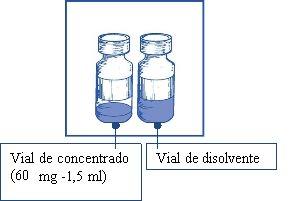
Etapa 1.1
Inspecionar o frasco de concentrado e o dissolvente proporcionado. A solução de concentrado e de dissolvente devem ser transparentes, praticamente livres de partículas.
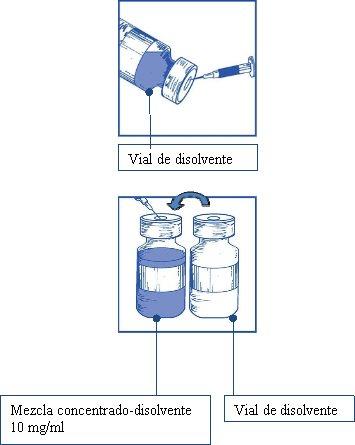 Etapa 1.2
Etapa 1.2
Utilizando uma seringa provida de uma agulha fixa, extrair de forma asséptica o conteúdo completodo dissolvente proporcionado, invertendo parcialmente o frasco.
Etapa 1.3
Injetar o conteúdo completono correspondente frasco de concentrado.
Para limitar ao máximo a formação de espuma ao injetar o dissolvente, dirigir a agulha para a parede interior do frasco de solução de concentrado e injetar lentamente.
Uma vez reconstituído, a solução resultante contém 10 mg/ml de cabazitaxel.
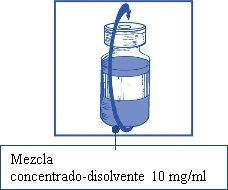
Etapa 1.4
Retirar a seringa e a agulha e misturar manualmente e suavemente, mediante inversões repetidas, até que se obtenha uma solução transparente e homogênea. Pode levar cerca de 45 segundos.
Etapa 1.5
Deixar a solução repousar durante aproximadamente 5 minutos e, em seguida, verificar se a solução é homogênea e transparente.
É normal que persista a espuma após este tempo.
Esta mistura concentrado-dissolvente resultante contém 10 mg/ml de cabazitaxel (pelo menos 6 ml de volume liberado). A segunda diluição deve ser realizada imediatamente (antes de 1 hora) como se detalha na Etapa 2.
Pode ser necessário mais de um frasco de mistura concentrado-dissolvente para administrar a dose prescrita.
Etapa 2: segunda diluição (final) para perfusão
Etapa 2.1
De forma asséptica, extrair a quantidade necessária de mistura concentrado-dissolvente (10 mg/ml de cabazitaxel), com uma seringa graduada provida de uma agulha fixa. Como exemplo, uma dose de 45 mg de Cabazitaxel Vivanta requereria 4,5 ml da mistura de concentrado-dissolvente preparada na Etapa 1.
Como pode haver espuma na parede do frasco desta solução, após a preparação descrita na Etapa 1, é preferível situar a agulha da seringa na metade do conteúdo durante a extração.
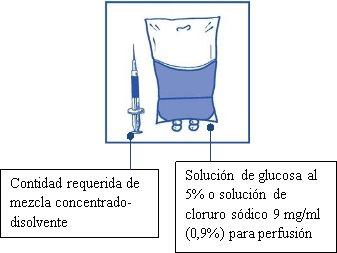
Etapa 2.2
Injetar em um recipiente estéril sem PVC de solução de glicose a 5% ou solução de cloreto de sódio mg/ml (0,9%) para perfusão. A concentração da solução para perfusão deve estar entre 0,10 mg/ml e 0,26 mg/ml.
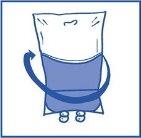
Etapa 2.3
Retirar a seringa e misturar o conteúdo da bolsa ou botija de perfusão manualmente, mediante movimento de balanço.
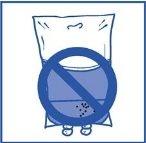
Etapa 2.4
Assim como todos os produtos parenterais, a solução de perfusão resultante deve ser inspecionada visualmente antes de usá-la. Como a solução de perfusão está sobressaturada, pode cristalizar com o tempo. Neste caso, não se deve utilizar a solução e deve ser eliminada.
A solução para perfusão deve ser utilizada imediatamente. No entanto, o tempo de conservação em uso pode ser mais longo sob as condições específicas mencionadas na seção Período de validade e precauções especiais de conservação.
A eliminação do medicamento não utilizado e de todos os materiais que tenham estado em contato com ele será realizada de acordo com a normativa local.
Método de administração
Cabazitaxel Vivanta é administrado em perfusão durante 1 hora.
Recomenda-se o uso de um filtro em linha de 0,22 micrómetros de tamanho de poro nominal (também denominado 0,2 micrómetros) durante a administração.
Não devem ser utilizados recipientes de perfusão de PVC ou conjuntos de perfusão de poliuretano para a preparação e administração da solução para perfusão.
- País de registo
- Substância ativa
- Requer receita médicaSim
- Fabricante
- Esta informação é apenas para referência e não constitui aconselhamento médico. Consulte sempre um médico antes de tomar qualquer medicamento. A Oladoctor não se responsabiliza por decisões médicas baseadas neste conteúdo.
- Alternativas a CABAZITAXEL VIVANTA 60 mg CONCENTRADO E SOLVENTE PARA SOLUÇÃO PARA PERFUSÃOForma farmacêutica: PERFURAÇÃO INJETÁVEL, 20 mg/mlSubstância ativa: cabazitaxelFabricante: Accord Healthcare S.L.U.Requer receita médicaForma farmacêutica: PERFURAÇÃO INJETÁVEL, 20 mgSubstância ativa: cabazitaxelFabricante: Eugia Pharma (Malta) LimitedRequer receita médicaForma farmacêutica: PERFURAÇÃO INJETÁVEL, 60 mgSubstância ativa: cabazitaxelFabricante: Reddy Pharma Iberia S.A.Requer receita médica
Alternativas a CABAZITAXEL VIVANTA 60 mg CONCENTRADO E SOLVENTE PARA SOLUÇÃO PARA PERFUSÃO noutros países
As melhores alternativas com o mesmo princípio ativo e efeito terapêutico.
Alternativa a CABAZITAXEL VIVANTA 60 mg CONCENTRADO E SOLVENTE PARA SOLUÇÃO PARA PERFUSÃO em Polónia
Alternativa a CABAZITAXEL VIVANTA 60 mg CONCENTRADO E SOLVENTE PARA SOLUÇÃO PARA PERFUSÃO em Ukraine
Médicos online para CABAZITAXEL VIVANTA 60 mg CONCENTRADO E SOLVENTE PARA SOLUÇÃO PARA PERFUSÃO
Avaliação de posologia, efeitos secundários, interações, contraindicações e renovação da receita de CABAZITAXEL VIVANTA 60 mg CONCENTRADO E SOLVENTE PARA SOLUÇÃO PARA PERFUSÃO – sujeita a avaliação médica e regras locais.



